Remove the water pump.
Remove the 4 bolts and pump pulley.
Remove the 2 bolts(C), then remove the alternator brace (A).
Remove the water pump (B) and gasket.
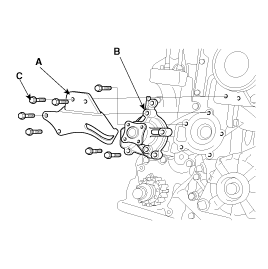
Drain the engine coolant.
System is under high pressure when the engine is hot. To avoid danger of releasing scalding engine coolant, remove the cap only when the engine is cool.
Remove drive belts.
Remove the timing belt.
Remove the timing belt idler.
Remove the water pump.
Remove the 4 bolts and pump pulley.
Remove the 2 bolts(C), then remove the alternator brace (A).
Remove the water pump (B) and gasket.

Removal of the thermostat would have an adverse effect, causing a lowering of cooling efficiency. Do not remove the thermostat, even if the engine tends to overheat.
Drain engine coolant so its level is below thermostat.
Remove water inlet (A), gasket and thermostat.
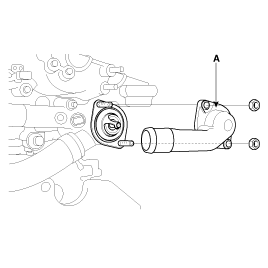
Remove the radiator cap to speed daring.
Loosen the radiator drain plug (A) and drain engine coolant.
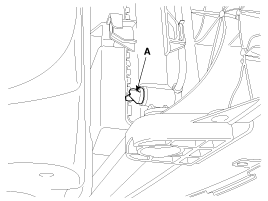
Disconnect the terminal(A) and remove the battery(B).
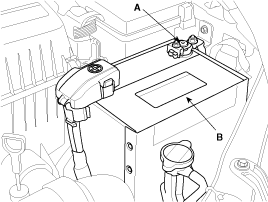
Remove the front bumper upper cover (A) and the air duct (B).
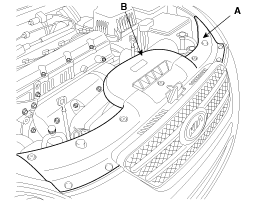
Remove the air cleaner assembly.
Disconnect the power train module (PCM) connector (A).
Disconnect the intake hose (B).
Remove the air cleaner assembly (C).
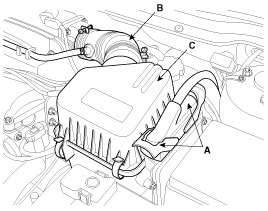
Disconnect the auto transaxle fluid (ATF) hose (A).
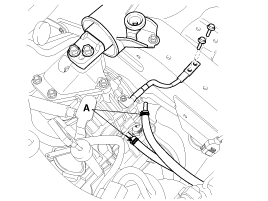
Disconnect the fan motor connector (A) and remove the radiator mounting bracket (B).
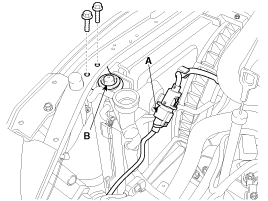
Remove the blower assembly(A).
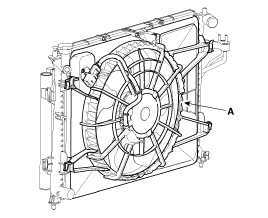
After pulling back the condenser fixing bracket(A), remove the radiator assembly.
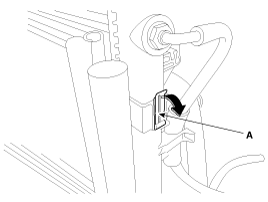
Install the water pump.
Install the water pump (B) and a new gasket with the 3 bolts(C).
Tightening torque
11.8 ~ 14.7Nm (1.2 ~ 1.5kgf.m, 8.7 ~ 10.8lb-ft)
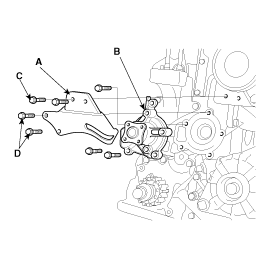
Install the alternator bracket (A) with the 2 bolts (D).
Tightening torque
19.6 ~ 23.5Nm (2.0 ~ 2.4kgf.m, 14.5 ~ 17.4lb-ft)
Install the 4 bolts and pump pulley.
Install the timing belt idler.
Install the timing belt.
Install drive belts.
Fill with engine coolant.
Start engine and check for leaks.
Recheck engine coolant level.
Place thermostat in thermostat housing.
Install the thermostat with the jiggle valve upward.
Install a new gasket (A) to the thermostat (B).
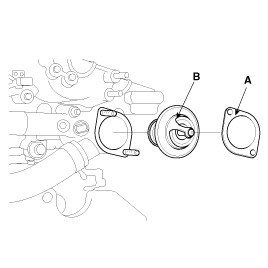
Install water inlet (A).
Tightening torque
14.7 ~ 19.6Nm (1.5 ~ 2.0kgf.m, 10.8 ~ 14.5lb-ft)

Fill with engine coolant.
Start engine and check for leaks.
Install the radiator.
Connect the fan motor connector (A) and install the radiator mounting bracket (B).

Connect the auto transaxle fluid (ATF) hose (A).

Install the upper radiator hose (A) and lower radiator hose (B).
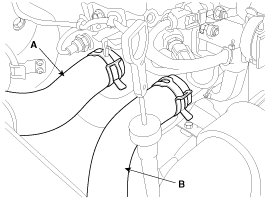
Install air cleaner assembly.
Install the front bumper upper cover (A) and the air duct (B).

Install battery (B) and connect teminal (A).
Fill with engine coolant.
Start engine and check for leaks.
Check each part for cracks, damage or wear, and replace the coolant pump assembly if necessary.
Check the bearing for damage, abnormal noise and sluggish rotation, and replace the coolant pump assembly if necessary.
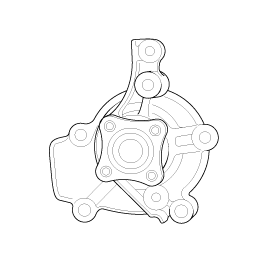
Check for coolant leakage. If coolant leaks from hole, the seal is defective. Replace the coolant pump assembly
A small amount of “weeping” from the bleed hole is normal.
Immerse the thermostat in water and gradually heat the water.
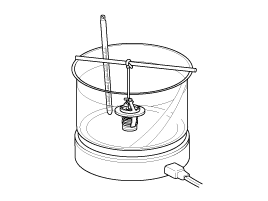
Check the valve opening temperature.
Valve opening temperature : 82 °C(177 °F)
Full opening temperature : 95 °C(205 °F)

If the valve opening temperature is not as specified, replace the thermostat.
Check the valve lift.
Valve lift : 8mm(0.3in.) or more at 95 °C(205 °F)
If the valve lift is not as specified, replace the thermostat.
When pouring engine coolant, be sure to shut the relay box lid and not to let coolant spill on the electrical parts or the paint. If any coolant spills, rinse it off immediately.
Slide the heater temperature control lever to maximum heat. Make sure the engine and radiator are cool to the touch.
Remove radiator cap (A).
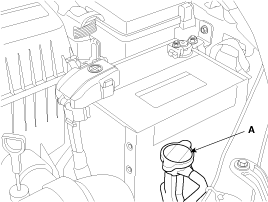
Loosen the drain plug, and drain the coolant.
Tighten the radiator drain plug securely.
Remove, drain and reinstall the reservoir. Fill the tank halfway to the MAX mark with water, then up to the MAX mark with antifreeze.
Mix the recommended antifreeze with water at the ratio of five to five(coolant 5 : water 5) in a clean container.
Use only genuine antifreese/coolant.
For best corrosion protection, the coolant concentration must be maintained year-round at 50% minimum. Coolant concentrations less than 50% may not provide sufficient protection against corrosion or freezing.
Coolant concentrations greater then 60% will impair cooling efficiency and are not recommended.
Do not mix different brands of antifreeze/coolants.
Do not use additional rust inhibitors or anti-rust products; they may not be compatible with the coolant.
Pour coolant into the radiator up to base of the filler neck, and install the radiator cap loosely.
Start the engine and let it run until it warms up (the radiator fan comes on at least twice).
Turn off the engine. Check the level in the radiator, add coolant if needed.
Put the radiatir cap on tightly, then run the engine again and check for leaks.
Remove the radiator cap, wet its seal with engine coolant, then install it no pressure tester.
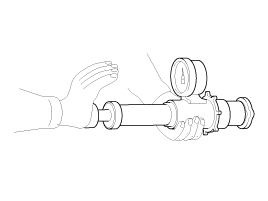
Apply a pressure of 93.16 ~ 122.58kpa(0.95 ~ 1.25kg/cm², 13.51 ~ 17.78psi).
Check for a drop in pressure.
If the pressure drops, replace the cap.
Wait until engine is cool, then carefully remove the radiator cap and fill the radiator with engine coolant, then install it on the pressure tester.
Apply a pressure tester to the radiator and apply a pressure of 93.16 ~ 122.58kpa(0.95 ~ 1.25kg/cm², 13.51 ~ 17.78psi).
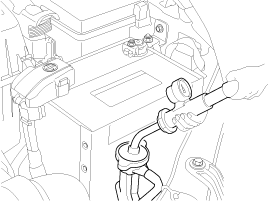
Inspect for engine coolant leaks and a drop in pressure.
Remove the tester and reinstall the radiator cap.
Check for engine oil in the coolant and/or coolant in the engine oil.